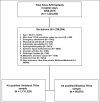Medicare/Medicaid Insurance Status Is Associated With Reduced Lower Bilateral Knee Arthroplasty Utilization and Higher Complication Rates
- PMID: 35472007
- PMCID: PMC10566829
- DOI: 10.5435/JAAOSGlobal-D-21-00016
Medicare/Medicaid Insurance Status Is Associated With Reduced Lower Bilateral Knee Arthroplasty Utilization and Higher Complication Rates
Abstract
Whether to undergo bilateral total knee arthroplasty (BTKA) depends on patient and surgeon preferences. We used the National Inpatient Sample to compare temporal trends in BTKA utilization and in-hospital complication rates among TKA patients ≥50 with Medicare/Medicaid versus private insurance from 2007 to 2016. We used multivariable logistic regression to assess the association between insurance type and trends in utilization and complication rates adjusting for individual-, hospital-, and community-level covariates, using unilateral TKA (UTKA) for reference. Discharge weights were used for nationwide estimates. About 132,400 (49.5%) Medicare/Medicaid patients and 135,046 (50.5%) privately insured patients underwent BTKA. Among UTKA patients, 62.7% had Medicare/Medicaid, and 37.3% had private insurance. Over the study period, BTKA utilization rate decreased from 7.18% to 5.63% among privately insured patients and from 4.59% to 3.13% among Medicaid/Medicare patients (P trend difference <0.0001). In multivariable analysis, Medicare/Medicaid patients were less likely to receive BTKA than privately insured patients. Although Medicare/Medicaid patients were more likely to develop in-hospital complications after UTKA (adjusted odds ratio, 1.06; 95% confidence interval, 1.002 to 1.12; P = 0.04), this relationship was not statistically significant for BTKAs. In this nationwide sample of TKA patients, BTKA utilization rate was higher in privately insured patients compared with Medicare/Medicaid patients. Furthermore, privately insured patients had lower in-hospital complication rates than Medicare/Medicaid patients.
Copyright © 2022 The Authors. Published by Wolters Kluwer Health, Inc. on behalf of the American Academy of Orthopaedic Surgeons.
Figures





Similar articles
-
Bilateral vs Unilateral Total Knee Arthroplasty: Racial Variation in Utilization and In-Hospital Major Complication Rates.J Arthroplasty. 2021 Apr;36(4):1310-1317. doi: 10.1016/j.arth.2020.10.057. Epub 2020 Nov 2. J Arthroplasty. 2021. PMID: 33234385 Free PMC article.
-
Insurance Status Affects In-Hospital Complication Rates After Total Knee Arthroplasty.Orthopedics. 2018 May 1;41(3):e340-e347. doi: 10.3928/01477447-20180226-07. Epub 2018 Mar 2. Orthopedics. 2018. PMID: 29494747
-
In-hospital complications and mortality of unilateral, bilateral, and revision TKA: based on an estimate of 4,159,661 discharges.Clin Orthop Relat Res. 2008 Nov;466(11):2617-27. doi: 10.1007/s11999-008-0402-5. Epub 2008 Aug 14. Clin Orthop Relat Res. 2008. PMID: 18704616 Free PMC article.
-
Characteristics of Hospital Stays for Super-Utilizers by Payer, 2012.2015 May. In: Healthcare Cost and Utilization Project (HCUP) Statistical Briefs [Internet]. Rockville (MD): Agency for Healthcare Research and Quality (US); 2006 Feb–. Statistical Brief #190. 2015 May. In: Healthcare Cost and Utilization Project (HCUP) Statistical Briefs [Internet]. Rockville (MD): Agency for Healthcare Research and Quality (US); 2006 Feb–. Statistical Brief #190. PMID: 26247093 Free Books & Documents. Review.
-
Medicaid and Medicare Utilization of Direct-Acting Antiviral Medications for Patients With Hepatitis C.Gastro Hep Adv. 2024 Nov 4;4(3):100584. doi: 10.1016/j.gastha.2024.10.024. eCollection 2025. Gastro Hep Adv. 2024. PMID: 39931049 Free PMC article. Review. No abstract available.
Cited by
-
Association of Patient Race and Hospital with Utilization of Regional Anesthesia for Treatment of Postoperative Pain in Total Knee Arthroplasty: A Retrospective Analysis Using Medicare Claims.Anesthesiology. 2024 Feb 1;140(2):220-230. doi: 10.1097/ALN.0000000000004827. Anesthesiology. 2024. PMID: 37910860 Free PMC article.
-
Anesthesia Care for Patients Undergoing Total Joint Arthroplasty: A Narrative Review of Disparities in Regional Anesthesia and Recommendations for Future Research Directions.Curr Anesthesiol Rep. 2025;15(1):1. doi: 10.1007/s40140-024-00676-3. Epub 2024 Dec 26. Curr Anesthesiol Rep. 2025. PMID: 40385291
-
Incidence and risk factors of blood transfusion after total knee arthroplasty: A retrospective nationwide inpatient sample database study.Heliyon. 2024 Jul 10;10(14):e34406. doi: 10.1016/j.heliyon.2024.e34406. eCollection 2024 Jul 30. Heliyon. 2024. PMID: 39104503 Free PMC article.
-
The Influence of Patient Characteristics and Social Determinants of Health on Postoperative Complications Following Achilles Tendon Rupture.Foot Ankle Int. 2024 Aug;45(8):879-887. doi: 10.1177/10711007241250021. Epub 2024 May 26. Foot Ankle Int. 2024. PMID: 38798118 Free PMC article.
-
Increased Body Mass Index is Associated With Increased Cost for Primary Total Knee Arthroplasty Exclusive of Readmissions and Complications.Arthroplast Today. 2025 Apr 26;33:101689. doi: 10.1016/j.artd.2025.101689. eCollection 2025 Jun. Arthroplast Today. 2025. PMID: 40336955 Free PMC article.
References
-
- Wilson NA, Schneller ES, Montgomery K, Bozic KJ: Hip and knee implants: Current trends and policy considerations. Health Affairs 2008;27:1587-1598. - PubMed
-
- Mayfield CK, Haglin JM, Levine B, Della Valle C, Lieberman JR, Heckmann N: Medicare reimbursement for hip and knee arthroplasty from 2000 to 2019: An unsustainable trend. J Arthroplasty 2020;35:1174-1178. - PubMed
-
- Hooper GJ, Hooper NM, Rothwell AG, Hobbs T: Bilateral total joint arthroplasty: The early results from the New Zealand National Joint Registry. J Arthroplasty 2009;24:1174-1177. - PubMed
Publication types
MeSH terms
Grants and funding
LinkOut - more resources
Full Text Sources
Medical

